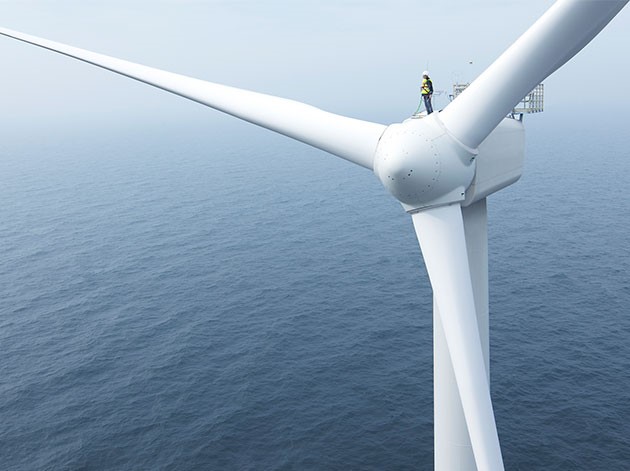Offshore Wind to Develop Into a $1 Trillion Business
Nowadays, the technology supplies 0.3 percent of global power generation. The latest IEA outlook forecasts that its capacity will increase 15-fold by 2040.
Currently, offshore wind technology supplies just 0.3 percent of global power generation. However, its potential is massive. Offshore Wind Outlook 2019, one of the International Energy Agency’s latest reports, anticipates that the global offshore wind power capacity will increase 15-fold over the next two decades, turning it into a $1 trillion business.
The report analyses the rapidly maturing technology of offshore wind energy. To issue the document, the agency collaborated with a multitude of high-level government representatives and international experts, including the Imperial College London, and used the latest satellite data, mapping out in detail the speed and quality of wind along hundreds of thousands of miles of coastline around the world.
Sailing the offshore winds
The global offshore wind market grew nearly 30 percent per year between 2010 and 2018, boosted by technology improvements such as larger turbines and floating foundations, as well as falling costs and supportive government policies. Currently, offshore wind technology holds a capacity of 23 gigawatts, of which 80 percent is sourced from Europe—the European Union’s capacity stands at almost 20 gigawatts, which under current policies, is set to increase by at least fourfold by 2030 and to rise to nearly 130 gigawatts by 2040. Yet, taking into account the European Union’s carbon neutrality aim, offshore wind capacity could jump to around 180 gigawatts by that time and become the continent’s largest single source of electricity.
The U.K., Germany and Denmark lead the technology’s development—the U.K. and Germany have the largest offshore wind capacity in operation, while Denmark produced 15 percent of its electricity from offshore wind in 2018. However, China added more capacity than any other country last year. China, in fact, is expected to play a big role in the technology’s long-term growth, forced by the need to reduce air pollution. In addition, offshore wind is highly attractive in the region as this kind of farms can be built near major population centers spread around the east and south of the country.
China aims to develop a project pipeline of 10GW by 2020 and it is likely that by 2025, it will have the largest offshore wind fleet of any country, overtaking the U.K. Specifically, the country is set to rise from 4GW today to 110GW by 2040. Furthermore, the authors note, policies designed to meet global sustainable energy goals could push that even higher: to more than 170GW.
The U.S. has good opportunities to diversify the country’s power mix, boasting offshore wind resources in the Northeast and along the East Coast, while floating foundations would make it possible to harness wind resources off the West Coast.
Newer offshore wind projects have capacity factors of 40 to 50 percent. At these levels, they match the capacity factors of gas- and coal-fired power plants in some regions, even if offshore wind is not always available. Moreover, this technology’s capacity factors exceed those of onshore wind and are about double those of solar photovoltaic. The downside is that offshore wind output varies according to the strength of the wind, but its hourly variability is lower than that of solar photovoltaic—it typically fluctuates up to 20 percent on an hourly basis, while that of solar photovoltaic varies up to 40 percent.
All these features place offshore wind in a category of its own: a variable baseload technology that can generate electricity throughout the day and produce more electricity in winter months in Europe, the U.S. and China, as well as during the monsoon season in India. This high availability and predictable seasonal patterns contribute to electricity security, more so than other variable renewables. In addition, it also has the advantage of avoiding many land use and social acceptance issues that other variable renewables are facing.
How much does it cost?
The average upfront cost to build a 1GW offshore wind project—including transmission, which these days accounts for about one-quarter of total offshore wind cost, increasing as projects move further from shore—was more than $4 billion last year. Financing costs account for 35 to 50 percent of overall generation cost and the levelized cost of electricity produced by offshore wind is projected to decline by nearly 60 percent by 2040.
Due to the relatively high upfront capital costs—a 250-megawatt project costs around $1 billion—investment in offshore wind parks is mainly made by large utilities and investment funds. In contrast, solar photovoltaic and onshore wind have much lower upfront costs, as well as fewer hurdles to entry for smaller players.
Investment in the wind industry rose to nearly $20 billion in 2018, up from less than $8 billion in 2010. Offshore wind investment last year accounted for nearly one-quarter of global investment in the wind sector and 6 percent of all investment in renewable energy. Last year, about half of total investment in wind power and one-quarter of total investment in renewable energy took place in the European Union.
Technology manufacturers and performance
Builders of offshore wind turbines are mostly based in Europe. Spanish-headquartered Siemens Gamesa and MHI Vestas—a joint venture between Vestas and Mitsubishi Heavy Industries—dominated the offshore wind industry, accounting for more than two-thirds of the offshore wind capacity installed last year. Combined, these two manufacturers account for more than 80 percent of all offshore capacity commissioned from 1995 through the end of 2018. Specifically, Siemens Gamesa sold offshore wind capacity totaling nearly 14 gigawatts, while MHI Vestas followed with nearly 4GW of capacity sold during the same period.
Just like any other technology, offshore wind has advanced greatly in the last decade, both in physical size and in rated power output. Turbines available in 2010 had the top height at around 328 feet and a generating capacity of 3MW, while in 2016, an 8MW turbine had doubled in height, with the swept area registering an increase of 230 percent. A larger swept area means more wind can be captured per turbine. Currently, a 12MW turbine that has a 352-foot blade and measures 853 feet in height is under development, triple the height of the Flatiron Building. Moreover, the industry is targeting even larger 15 to 20MW turbines for 2030. Although the increase in turbine size and rating requires more capital as these pose construction challenges and require larger foundations, it will translate to reduced operation and maintenance costs.
Technology headwinds
There are, of course, challenges that could hinder the evolution of this technology. One such challenge is the onshore grid infrastructure, vital to offshore wind technology. This issue doesn’t involve just the developers of these transmission lines but also includes lawmakers, responsible for passing regulations to encourage efficient planning and design practices that support the long-term vision for offshore wind. Failing to do so, without fitting grid reinforcements and expansion, there is the risk of large amounts of power going unused.
The authors of the analysis also note that there is a pressing need to develop efficient supply chains in order to enable the delivery of low-cost projects. This means a hefty cost implying multibillion-dollar investments, which can be difficult in the face of uncertainty. Governments need to step in and facilitate investment of this kind by creating a long-term vision for offshore wind and defining precisely the measures to be taken to help turn that vision into reality. Clear measures would also increase electricity security as it would system planning to ensure reliability during periods of low wind availability.
Colossal potential
The report’s authors estimated that the technical potential for offshore wind worldwide is more than 120,000 gigawatts, with the capacity to generate more than 420,000 terawatt-hours of electricity per year. This would be enough to meet 11-times the global energy demand in 2040, in theory. Accounting for the availability of transmission and distribution infrastructure, things are not so idealistic: Due to their long coastlines, Russia (80,000 terawatt-hours per year or 20 percent of the total), Canada (50,000 terawatt-hours per year or 12 percent of the total) and the U.S. (more than 45,000 terawatt-hours per year or 11 percent of total) together account for more than 40 percent of the global technical potential. Even so, excess resources could be harnessed for export.
The study looked at the main regions separately: Europe (excluding Greenland and overseas territories) has a technical potential of offshore wind of 50,000 terawatt-hours per year, which is more than 10-times demand. In the U.S., counting just the contiguous states, shallow waters have the potential to provide more than 3,300 terawatt-hours per year and deep waters more than 8,700 terawatt-hours annually. Some of this potential is located off the Atlantic coast, near major cities like Washington, D.C., Boston and New York. The Great Lakes region also posts a technical potential of more than 900 terawatt-hours per year.








You must be logged in to post a comment.